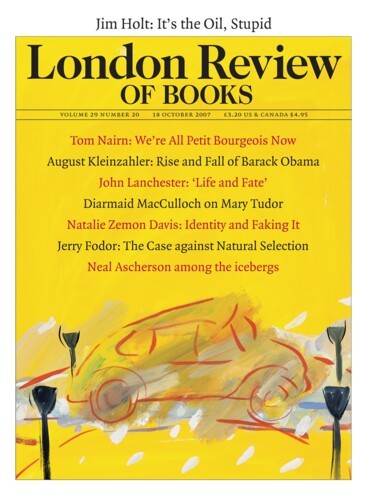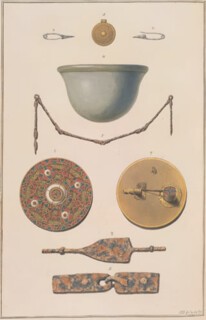The world in which the Society of Antiquaries came into existence in 1707 had been created in 4004 BC, on 22 October, which was a Saturday. So at least Archbishop Ussher had calculated, using the Biblical sources which were the only ones available to him, or anyone else. Antiquaries, those who study the physical remains of the past as well as the written records, had been around for several hundred years, but the foundation of the society, whose 300th anniversary is celebrated in Making History,* brought them closer to the mainstream of national life than ever before. Not that they exactly sought the limelight. Although their headquarters has been in Burlington House in Piccadilly since 1874, on the same site as the Royal Academy, this is the first time the two institutions have collaborated on any scale. Now they have combined to show off, in a modest way, the antiquaries’ accumulated treasures.
A century or so after its foundation, the society’s members were among the first to chafe against the constraints of Ussher’s chronology, but to begin with there was plenty to do within it. They expanded the scope of history, taking it beyond the classical, political and military to examine all that was left of the material past. ‘Whatsoever,’ as Francis Bacon had put it, ‘singularity, chance and the shuffle of things hath produced,’ old coins, flints, armour, pottery and bits of parchment, these were the antiquaries’ stock in trade. Gathered like anatomists around the society’s table they sifted and discussed each others’ finds, and through their researches and publications gave birth to local history, social history, history of costume, oral history and archaeology.
Not surprisingly, they acquired a reputation for crankiness. Drawings in Making History show them in action opening tombs, taking pickaxes to prehistoric barrows and climbing across a spindly ladder high up in Lincoln Cathedral to inspect the concealed ‘prison chamber’. Since the study of local antiquities did not require a classical education or a grand tour, members might be of modest means. They included clergymen, journalists, antique dealers and publishers, and one of the many joys of the exhibition is the contrast between the somewhat dowdy antiquaries, looking at best respectable in oils and at worst ridiculous in the hands of Rowlandson and Cruikshank, and the thrilling glamour of many of the exhibits. Among them are the processional cross carried by Richard III’s supporters at the Battle of Bosworth; a red, blue and gold filigree Anglo-Saxon brooch, recovered from the Kingston Down barrow in 1771 by the young Henry Faussett under the directions of his antiquarian father, the Rev. Bryan, who was confined to his carriage by gout, and a ‘jousting cheque’ or scorecard from the Field of the Cloth of Gold.
Down the centre of the first gallery runs an immense genealogical roll, made up of two parts, which traces the descent of Charles II. Pedigrees were literally the lifeline of antiquarianism, the slender thread of human provenance by which the present might feel its way into the labyrinth of the past. The first part, made in c.1455, shows the ancestry of Henry VI in a series of exquisite illuminations that take the reader back through Noah’s Flood, past Cleopatra to the Garden of Eden, where a fashionably dressed snake presses a second apple on Eve. The continuation of the pedigree two centuries later goes forward to the Restoration, by which time the distinction between myth and history was becoming sharper in the public mind. Charles II probably did not believe literally in his descent from Ham, Shem or Japhet, but the propaganda value of an unbroken divine line had not changed. It was as useful in shoring up his throne after the Commonwealth as it had been to Henry VI during the Wars of the Roses.
The remains of history are never politically neutral, as antiquaries knew to their cost. The Society of 1707 was not the first. Another society was founded under Elizabeth I. But her successor, James I, ‘took a little Mislike’ to it and it fizzled out. Charles I made the antiquary Robert Cotton close his famous library, thinking it seditious. Suspected at various times of anti-Stuart sympathies, closet Catholicism, republicanism, even as late as 1797 the antiquaries could be denounced by George III as a ‘Popish cabal’. Still, they stuck to the motto associated with their emblem, the bronze Lamp of Knowledge: non exstinguere, it ‘shall not be extinguished’.
The Lamp, which is ‘curious’ – to use a favourite antiquarian adjective – rather than attractive, was dug up in Windsor in 1717, when it was thought to be Roman. It was also thought to be a table lamp and so somebody put a base on it. Now known to be medieval and believed to be a Jewish ritual hanging lamp, it is perhaps a more fitting symbol of the nature of historical inquiry than the antiquaries intended. Half antiquity, half Georgian candlestick and still not fully understood, it represents the mutability of knowledge. Things that remain the same look different from time to time. The exhibition organisers might have borne this in mind when writing some of their condescending text panels. John Bargrave is taken to task for not distinguishing between the ‘categories’ of ‘antiquity’ and ‘curiosity’ in his 17th-century cabinet, but they were not clear categories in his day. Antiquarianism flourished before history was a profession, or even a university subject, and the ability to work freely across what are now distinct disciplines was one of its greatest strengths. When science and art had yet to separate, the engravings of William Blake and the watercolours of Girtin and Turner, still among the society’s treasures, were of as much service to the antiquary as his hammer and shovel.
But if there is any intention to give an impression of steady progress towards enlightenment and modern field archaeology, it is undermined by the exhibits themselves. There are rubbings of brasses since sold for scrap metal, copies of the medieval murals of the Palace of Westminster destroyed in building work, a drawing of a hanging bowl which was ‘the most remarkable piece of pre-Conquest plate ever found in England’, and went missing some time after 1858. A third of Bryan Faussett’s finds at Kingston Down were destroyed in the Second World War. The battle against time will always be uneven, but Making History chronicles some of its most heroic skirmishes.
Send Letters To:
The Editor
London Review of Books,
28 Little Russell Street
London, WC1A 2HN
letters@lrb.co.uk
Please include name, address, and a telephone number.


